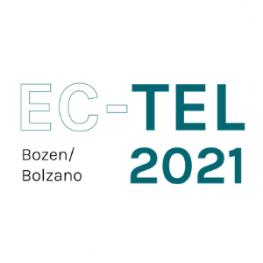Speakers
Jérôme Brender
MOBOTS Group, and LEARN - Center for Learning Sciences, Ecole Polytechnique Fédérale de Lausanne, SwitzerlandJanika Leoste
School of Educational Sciences, Tallinn University, EstoniaCaterina Senette
Istituto di Informatica e Telematica - CNR, ItalyStart
23/09/2021 - 11:00
End
23/09/2021 - 12:30
Address
Zoom Room 2 @ EC-TEL Gather Town View mapPaper Session 6: Innovative Teaching Approaches
Chair:  Azzeddine Benabbou
Azzeddine Benabbou
Investigating the Role of Educational Robotics in Formal Mathematics Education: The Case of Geometry for 15-Year-Old Students
Jérôme Brender[1,2], Laila El-Hamamsy[1,2], Barbara Bruno[2,3], Frédérique Chessel-Lazzarotto[1], Jessica Dehler Zufferey[1] and Francesco Mondada[1,2] [1] Center LEARN, Ecole Polytechnique Fédérale de Lausanne (EPFL), Switzerland [2] Mobots Group, Ecole Polytechnique Fédérale de Lausanne (EPFL), Switzerland [3] CHILI Lab, Ecole Polytechnique Fédérale de Lausanne (EPFL), Switzerland
Abstract: Research has shown that Educational Robotics (ER) enhances student performance, interest, engagement and collaboration. However, until now, the adoption of robotics in formal education has remained relatively scarce. Among other causes, this is due to the difficulty of determining the alignment of educational robotic learning activities with the learning outcomes envisioned by the curriculum, as well as their integration with traditional, non-robotics learning activities that are well established in teachers’ practices. This work investigates the integration of ER into formal mathematics education, through a quasi-experimental study employing the Thymio robot and Scratch programming to teach geometry to two classes of 15-year-old students, for a total of 26 participants. Three research questions were addressed: (1) Should an ER-based theoretical lecture precede, succeed or replace a traditional theoretical lecture? (2) What is the students’ perception of and engagement in the ER-based lecture and exercises? (3) Do the findings differ according to students’ prior appreciation of mathematics? The results suggest that ER activities are as valid as traditional ones in helping students grasp the relevant theoretical concepts. Robotics activities seem particularly beneficial during exercise sessions: students freely chose to do exercises that included the robot, rated them as significantly more interesting and useful than their traditional counterparts, and expressed their interest in introducing ER in other mathematics lectures. Finally, results were generally consistent between the students that like and did not like mathematics, suggesting the use of robotics as a means to broaden the number of students engaged in the discipline
📄 Read More: https://link.springer.com/chapter/10.1007/978-3-030-86436-1_6
The Role of Social Practices of Knowledge Appropriation for Sustaining TEL Innovations in the Classroom
Janika Leoste, Tobias Ley, Mati Heidmets and Jelena Stepanova Tallinn University, Estonia
Abstract: Schools strive to integrate emerging technologies via innovative TEL practices to ensure educational change. We examined social practices of knowledge appropriation (Social Practices) as indicators of TEL innovation process status, drawing data from interviews with 22 teachers who had adopted an innovative teaching method, the use of educational robots in Math, in their regular teaching practices. Results imply that teachers rely on different Social Practices in different innovation process stages. TEL innovation has become a part of teachers’ practices after they have intensively adapted the innovation to their needs and they have started to actively create awareness about the method and formalize their knowledge.
📄 Read More: https://link.springer.com/chapter/10.1007/978-3-030-86436-1_3
Visual Aids for Teaching Piano to Students with Autism: Designing a Web App Through Practice
Caterina Senette, Maria Claudia Buzzi, Marina Buzzi and Amaury Trujillo IIT-CNR, Italy
Abstract: This paper describes an accessible web app for mobile devices that serves as a support tool to teach students with autism the basics of music using a virtual piano keyboard. Within the app, learning material is presented in a gradual and structured way, in which each educational unit can be customized according to students’ needs and preferences; for instance, visual and auditory aids aimed at special-needs learners can be deactivated over time to make the learning outcomes independent from them. In order to study and improve both the user and use contexts for the interface design and interaction mechanisms, we recruited seventeen adolescents with autism at two different stages of the app development cycle. By collecting a variety of interaction data, we refined design choices and iteratively evaluated accessibility, usability, and acceptability aspects of the app. Results of this process appear to confirm the feasibility of our approach while providing valuable observational data for other researchers working on similar solutions. In addition, this work further corroborates the positive role of technology in motivating adolescents with low- and medium-functioning autism in their learning, and highlights the potential of music as a learning object per se, and not only as a medium for mastering other skills.
📄 Read More: https://link.springer.com/chapter/10.1007/978-3-030-86436-1_4



